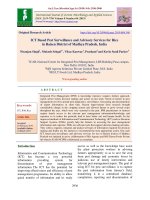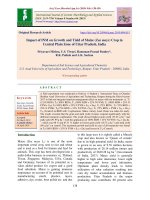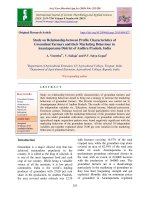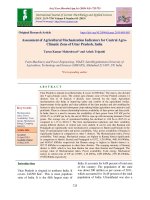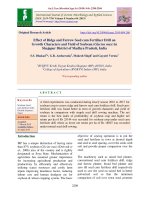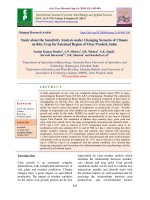Seasonal variation of calving in Murrah buffalo in different agro climatic zones of Uttar Pradesh, India
Bạn đang xem bản rút gọn của tài liệu. Xem và tải ngay bản đầy đủ của tài liệu tại đây (181.04 KB, 6 trang )
Int.J.Curr.Microbiol.App.Sci (2019) 8(5): 1234-1239
International Journal of Current Microbiology and Applied Sciences
ISSN: 2319-7706 Volume 8 Number 05 (2019)
Journal homepage:
Original Research Article
/>
Seasonal Variation of Calving in Murrah Buffalo in
different Agro Climatic Zones of Uttar Pradesh, India
V.V. Potdar*, J.R. Khadse, S.A. Joshi, Y.S. Gaundare,
Marimuthu Swaminathan, N.L. Phadke and A.B. Pande
BAIF Development Research Foundation, Central Research Station, Pune 412 202, India
*Corresponding author
ABSTRACT
Keywords
Buffalo, Caving,
Agro climatic zones
Article Info
Accepted:
12 April 2019
Available Online:
10 May 2019
The present study was carried out to estimate seasonal variation of calving in Murrah
buffaloes. The study was conducted in Central plain of Uttar Pradesh (Etah and Unnao),
Mid-western plain of Uttar Pradesh (Bareilly) and Western plain zone Uttar Pradesh
(Meerut) of India on 2828Murrah buffaloes theses buffaloes were inseminated during June
2010 to December 2014at BAIF’s field Artificial Insemination centers which provide
door-step artificial insemination service at villages level. The result indicated that calving
of Murrah buffaloes occurred throughout year. In Central plain of Uttar Pradesh maximum
calving observed in October month 18.70% & August 15.44%. In Mid-western plain of
Uttar Pradesh maximum calving observed in October month 17.59% & December 14.54%
while in Western plain zone Uttar Pradesh maximum calving observed in August month
23.48% &October 17.39%.On the basis of season majority of calving observed between
July to January months. It can be concluded that Murrah buffaloes have tendency to calve
more in the days with shorter photoperiod as compare to days with longer photoperiod.
Introduction
The estimate of world buffalo population is
approximately 185.29 million dispersed in
42countries, out of which 97% (179.75
million) are found only in Asia. According to
19th Livestock Census 2012 it has reached
upto 108.7 millions India has approximately
57% (108.7 million) of the total world buffalo
population. The water buffalo contributes
immensely to the agricultural economy
through milk, meat, hides and draught power.
Share of buffalo milk occupies the highest
position in Indian dairy industry, contributing
about 56% of total milk (110MT) produced
by its varied population which is less than
half that of the cattle population. Population
size of Murrah is 20.49 million which
constitutes 19.45% of the total buffalo
population of India. Murrah buffalo is the
most efficient milk producer and has better
adaptability throughout India. The biggest
limiting factor influencing the productivity of
the buffaloes is the seasonality in displaying
oestrus, conception rate and calving rate
(Shah et al., 1989; Singh and Lal, 1994;
Srivastava and Sahni, 1999). This may be the
cause of the prolonged intercalving period
1234
Int.J.Curr.Microbiol.App.Sci (2019) 8(5): 1234-1239
since buffalo calving during the unfavorable
season may not resume their ovarian activity
until the following favorable season,
decreasing their reproductive efficiency. Very
limited information is available on the
seasonal trend in the calving of the buffaloes
so the objective of the study was to document
the calving pattern of Murrah buffaloes in the
Uttar Pradesh.
Materials and Methods
The study was conducted in Central plain of
Uttar Pradesh (Etah and Unnao), Mid-western
plain of Uttar Pradesh (Bareilly) and Western
plain zone Uttar Pradesh (Meerut) of India on
2828Murrah buffaloes theses buffaloes were
inseminated during June 2010 to December
2014at BAIF’s field Artificial Insemination
centers which provide door-step artificial
insemination service at villages level.Keeping
in view the climatological data, the year was
divided into five seasons: winter (December
to January), spring (February to April),
summer (May to June), rainy (July to
September) and autumn (October to
November). Season categorization has been
done as per reference and work over
Seasonality Of Calving In Bhadawari And
Murrah Buffaloes In Bundelkhand, India done
by B.P. Kushwaha, Sultan Singh and S.B.
Maity Buffalo Bulletin (December 2011).
Results and Discussion
When the data were grouped according to the
various seasons, the highest percentage of
calving (36) took place in the rainy (July to
September) season, which was followed by
the autumn (29) and the winter seasons (17).
The lowest percentage (8) of calving was
recorded in the spring season while 9 %
calving observed in summer season.
In the month wise study of calving study
highest percentage of calving took place in
the months of October and August 17 and15
percent, respectively followed by September,
October and November 13,12 and 12 percent
respectively. The carvings in the month of
May, June and July was 4, 6 and 9 percent
respectively. Lowest percentage of calving
took place in the months of January,
February, March, April 4, 3, 3 and 2 percent
respectively. The results of the present study
indicated that the rainy and the autumn
seasons were the main calving seasons for
Murrah buffaloes, when more than 65% of the
calving took place.
The findings of the present study were in
accordance with the findings of Hassan et al.,
(2007) and Hussain (2007) in Nili Ravi
buffaloes in Pakistan. Anonymous (2008) also
reported the main calving period between July
to December in Murrah, Pandharpuri,
Jaffrabadi and Surti buffaloes Haryana,
Maharashtra, Gujrat and Rajasthan states,
respectively. Sule et al., (2001) confirmed a
distinct seasonality in breeding behavior in
Surti buffaloes reared in Rajasthan. Reddy et
al., (1999) also reported August to November
the most favorable period for reproduction in
Murrah buffaloes.
Agrawal (2003) reported that a determining
factor in production and reproduction of farm
animals all over the world is environment.
Season affects the breeding efficiency, and
buffaloes have tendency to performance better
during the cool months; 70-80% of calvings
in buffaloes occur between July and January.
Misra and Sengupta (1965) reported that in
India, the buffalo’s sexual vigour declines
during the summer and improves with the
onset of the colder season. El-Sheikh (1987)
reported more than 63% calvings occurred
during the colder season in Egyptian
buffaloes.
1235
Int.J.Curr.Microbiol.App.Sci (2019) 8(5): 1234-1239
Calving observations in central zone
Central zone of Uttar Pradesh is area of
Unnao district. The District is roughly a
parallelogram in shape and lies between
Latitude 26°8' N & 27°2' N and Longitude
80°3' E & 81°3' E. It is bounded on the North
by District Hardoi. It has a subtropical climate
(Köppen climate classification: Cfa) with hot
summers and cool winters. The soil is mostly
alluvial. The average temperature for the year
is 25°C. June, with an average temperature of
33°C is the warmest month, while the coolest
month of the year is January, with an average
temperature of 15°C. When the data were
grouped according to the various seasons, the
highest percentage of calving (35) took place
in the rainy season, which was followed by
the autumn (33) and the winter seasons (17).
The lowest percentage (7) of calving was
recorded in the summer season while (8)
calving observed in spring season. In the
month wise study of calving study highest
percentage of calving took place in the
months of August and October15 and18
percent, respectively followed by November
12 percent. The calvings in the month of
January, February, June, July, September and
December month were 4, 5, 7, 12, 12 percent
respectively. The lowest percentage of
calving (2 to 3) took place in the months of
March, April and May in the Murrah
buffaloes.
Calving observations in Mid-western plain
zone
Mid-western plain zone of Uttar Pradesh is
area of Bareilly district. Bareilly is in northern
India, at 28°10′N 78°23′E. On its east are
Pilibhit and Shahjahanpur. Bareilly has a
humid subtropical climate (Köppen climate
classification: Cfa) with hot summers and
cool winters. The average temperature for the
year is 25°C. June, with an average
temperature of 32.8°C is the warmest month,
while the coolest month of the year is
January, with an average temperature of
15°C. When the data were grouped according
to the various seasons, the highest percentage
of calving (32) took place in the rainy season,
which was followed by the autumn (29) and
the winter seasons (20). The lowest
percentage (8) of calving was recorded in the
summer season while (10) calving observed
in spring season. In the month wise study of
calving study highest percentage of calving
took place in the months of October and
December 18 and 15 percent, respectively
followed by September, November 12
percent. The calvings in the month of January,
June, July, August month were 6, 5, 8 and 11
percent respectively. The lowest percentage
of calving (3 to 4) took place in the months of
February, March, April and May in the
Murrah buffaloes.
Calving observations in South Western
Semi arid zone
South Western Semi Arid zone of Uttar
Pradesh is area of Etah district. The District is
roughly a parallelogram in shape and located
between 27.63°N and 78.67°E [5]. It has an
average elevation of 170 metres (557 feet).
Etah has a subtropical climate (Köppen
climate classification: Cfa) with hot summers
and cool winters. The soil is mostly alluvial.
The average temperature for the year is 25°C.
June, with an average temperature of 33°C is
the warmest month, while the coolest month
of the year is January, with an average
temperature of 14°C.
When the data were grouped according to the
various seasons, the highest percentage of
calving (39) took place in the rainy season,
which was followed by the autumn (26) and
the winter seasons (16). The lowest
percentage (8) of calving was recorded in the
summer season while (12) calving observed
in spring season. In the month wise study of
1236
Int.J.Curr.Microbiol.App.Sci (2019) 8(5): 1234-1239
calving study highest percentage of calving
took place in the months of August,
September and October 15, 13 and13 percent,
respectively
followed
by
November,
December 12 percent respectively. The
carvings in the month of January, May June
and July, were 5, 4, 8 and 10 percent
respectively. The lowest percentage of
calving took place in the months of February,
March, April 3, 3 and 2 percent respectively.
Calving observations in Western plain zone
Western Plain zone of Uttar Pradesh is area of
Merrut district. Meerut district lies between
28°57’ to 29°02’ North latitude and 77°40’ to
77°45’ East longitude in the Indo-Gangetic
plains of India. It is bound on the north by
Muzaffarnagar district, in the south by
Bulandshahar district while Ghaziabad and
Baghpat districts form the southern and
western limits. Summers last from early April
to late June during and are extremely hot,
with temperatures reaching 49 °C. The
monsoon arrives in late June and continues till
the middle of September. The average
temperature for the year is 27°C. June, with
an average temperature of 33°C is the
warmest month, while the coolest month of
the year is January, with an average
temperature of 14°C.
When the data were grouped according to the
various seasons, the highest percentage of
calving (51) took place in the rainy season,
which was followed by the autumn (24) and
the winter seasons (8). The lowest percentage
(4) of calving was recorded in the spring
season while (12) calving observed in
summer season. In the month wise study of
calving study highest percentage of calving
took place in the months of August,
September and October 23,15,17 and 13
percent, respectively followed by November,
December 7,8 percent respectively. The
carvings in the month of May June and July,
were 7, 5,13percent respectively. The lowest
percentage of calving took place in the
months of January, March, April 0.4,3 and 2
percent respectively (Table 1 and 2).
Table.1 Season and cluster wise number of observation
CLUSTER
AUTOMAN RAINY SPRING SUMMAR WINTER Grand
Total
356
375
88
78
178
1075
WESTERN 211
230
74
60
146
721
SOUTH WESTERN 205
SEMI ARID
310
61
95
132
803
CENTRAL
MID
PLAIN
WESTERN PLAIN
55
117
10
28
19
229
Grand Total
827
1032
233
261
475
2828
1237
Int.J.Curr.Microbiol.App.Sci (2019) 8(5): 1234-1239
Table.2 Month and cluster wise number of observations
MONTH
CALVING
1
2
3
4
5
6
7
8
9
10
11
12
Grand Total
OF CENTRAL MID
PLAIN
47
41
44
25
26
19
18
30
29
22
49
38
80
61
166
82
129
87
201
127
155
84
131
105
1075
721
WESTERN SOUTH WESTERN
SEMI ARID
38
25
22
14
32
63
82
122
106
107
98
94
803
It is concluded as on the basis of season
majority of calving observed between July to
January months. It can be concluded that
Murrah buffaloes have tendency to calve
more in the days with shorter photoperiod as
compare to days with longer photoperiod. The
seasonality in calving observed in Murrah
breed indicate that the photoperiodicity in
different seasons plays a greater role than the
diet, as these animals were maintained under
an intensive system of management and fed
properly throughout the year.
Acknowledgments
The authors are thankful to President, Senior
Vice President, Management team of BAIF
Development Research Foundation and all
stakeholders in study area those who
participated and cooperated during study
References
Agrawal, K.P. 2003. Augmentation of
reproduction in buffaloes, p. 121. In
WESTERN
PLAIN
1
6
4
16
12
30
53
34
40
15
18
229
Proceedings of 4th Asian Buffalo
Congress lead paper.
El-Sheikh, A.S. 1987. The reproductive
performance of the buffalo in Egypt.
Indian J Dairy Sci.20: 8995.
Hassan, F., M.S. Khan, M.S. Rehman, M.
Sarwarand
S.A.
Bhatti.
2007.
Seasonality of calving in Nili-Ravi
buffaloes, purebred sahiwal and
crossbred cattle in Pakistan. Ital. J.
Anim. Sci., 6(Suppl. 2), 1298-1301.
Hussain, Z. 2007. Seasonal variation in
breeding and calving pattern of NiliRavi buffaloes in Azad Kashmir,
Pakistan. Buffalo Bull., 26(4): 127-130.
Kushwaha B.P. Sultan Singh and S.B. 2011.
Maity seasonality of calving in
Bhadawari and Murrah buffaloes in
Bundelkhand, India Buffalo Bulletin
(December 2011) Vol. 30 No. 4.
Misra, M.S. and B.P. Sengupta. 1965.
Climatic environment and reproductive
behavior of buffaloes. III. Observations
on semen quality of buffalo maintained
under two different housing conditions.
1238
Grand
Total
127
94
73
66
99
162
253
423
356
475
352
348
2828
Int.J.Curr.Microbiol.App.Sci (2019) 8(5): 1234-1239
Indian J. Dairy Sci., 18:130-133
Shah, S.N.H., A.H. Willemese and D.F.M.
Van deWiel. 1989. Influence of season
and parity on several reproductive
parameters on Nili-Ravi buffaloes in
Pakistan. Anim. Reprod. Sci., 21:77190.
Singh, B. and K. Lal. 1994. Effect of season
on the incidence of breeding and
conception rate in buffaloes. Indian J.
Anim. Sci., 64: 314-316.
Srivastava, S.K. and K.L. Sahni 1999. Effect
of season on oestrus and conception in
village cows and buffaloes. Indian Vet.
J., 76(5): 385-387.
Sule, S.R., A.L., Taparia, L.S. Jain and S.P.
Tailor. 2001. Reproductive status of
Surti buffaloes maintained under subhumid conditions of Rajasthan. Indian
Vet. J., 78(11): 1049-1051.
How to cite this article:
Potdar, V.V., J.R. Khadse, S.A. Joshi, Y.S. Gaundare, Marimuthu Swaminathan, N.L. Phadke
and Pande, A.B. 2019. Seasonal Variation of Calving in Murrah Buffalo in different Agro
Climatic Zones of Uttar Pradesh, India. Int.J.Curr.Microbiol.App.Sci. 8(05): 1234-1239.
doi: />
1239

